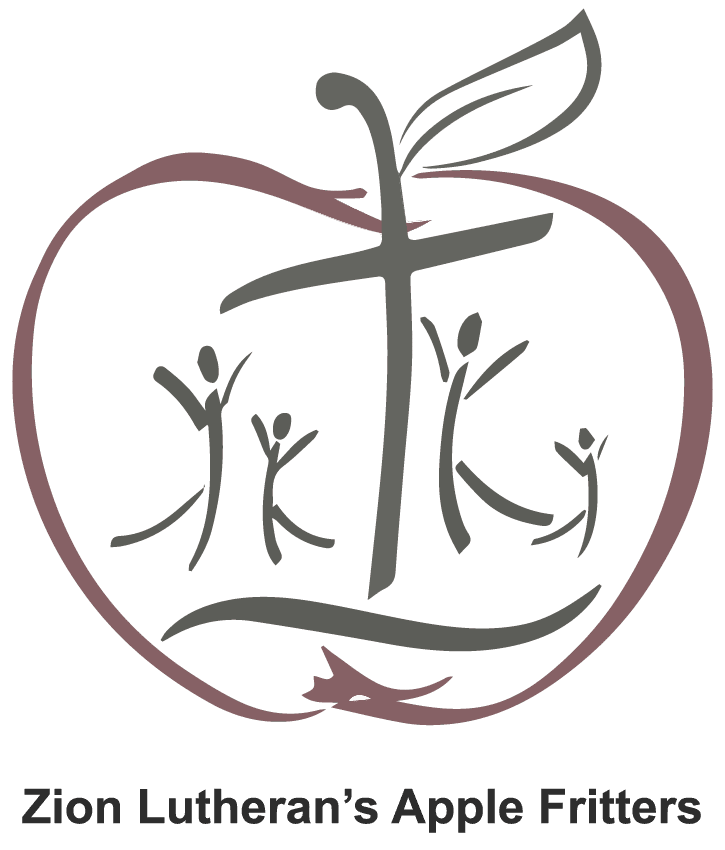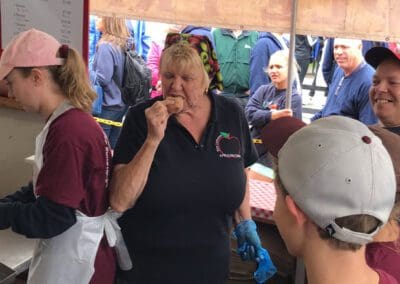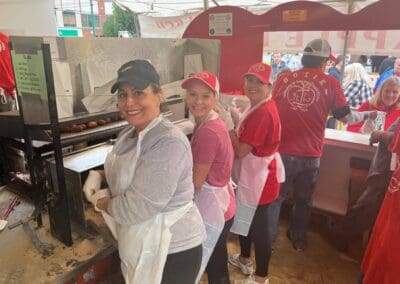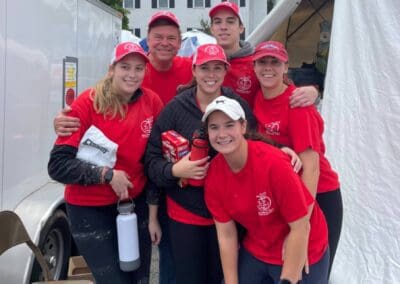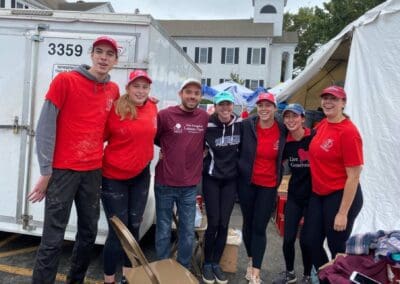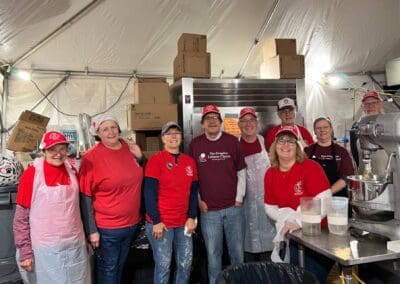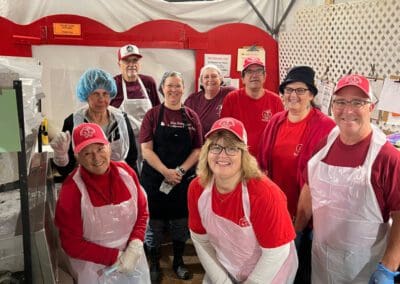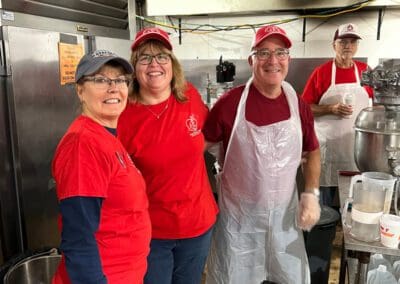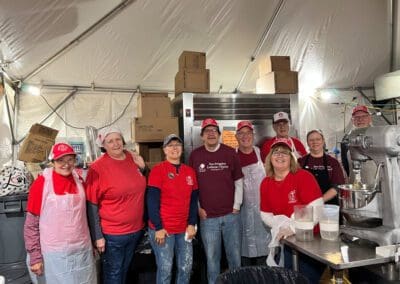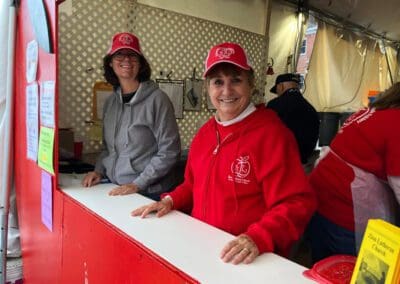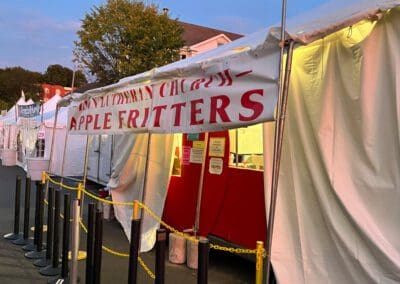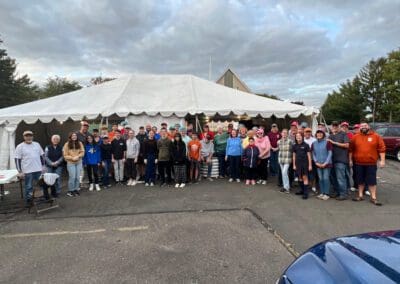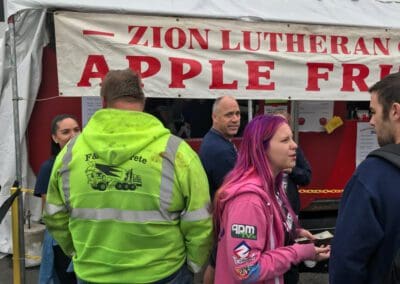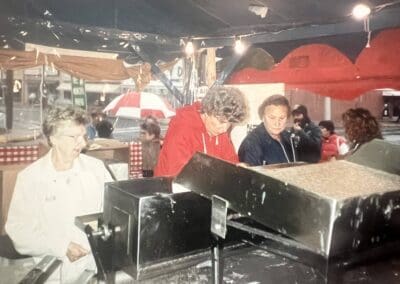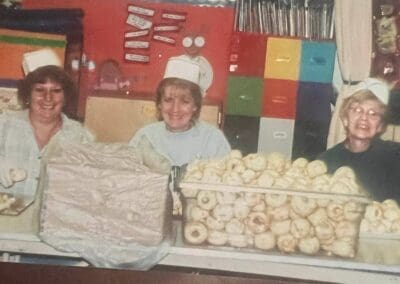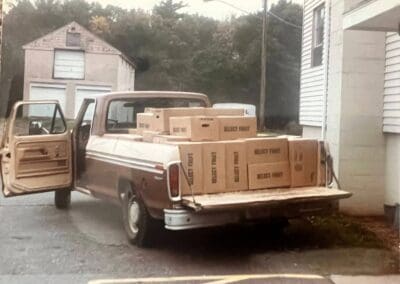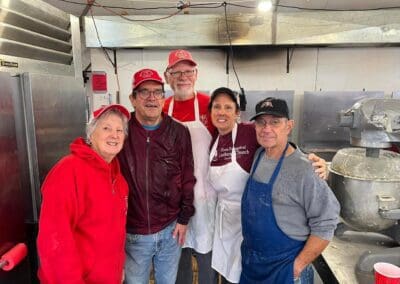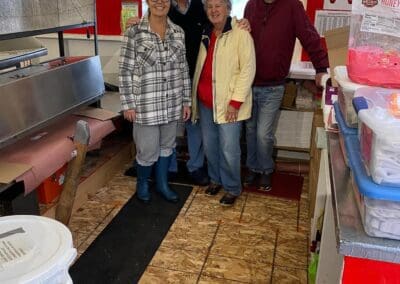The Story of the Apple Fritter…
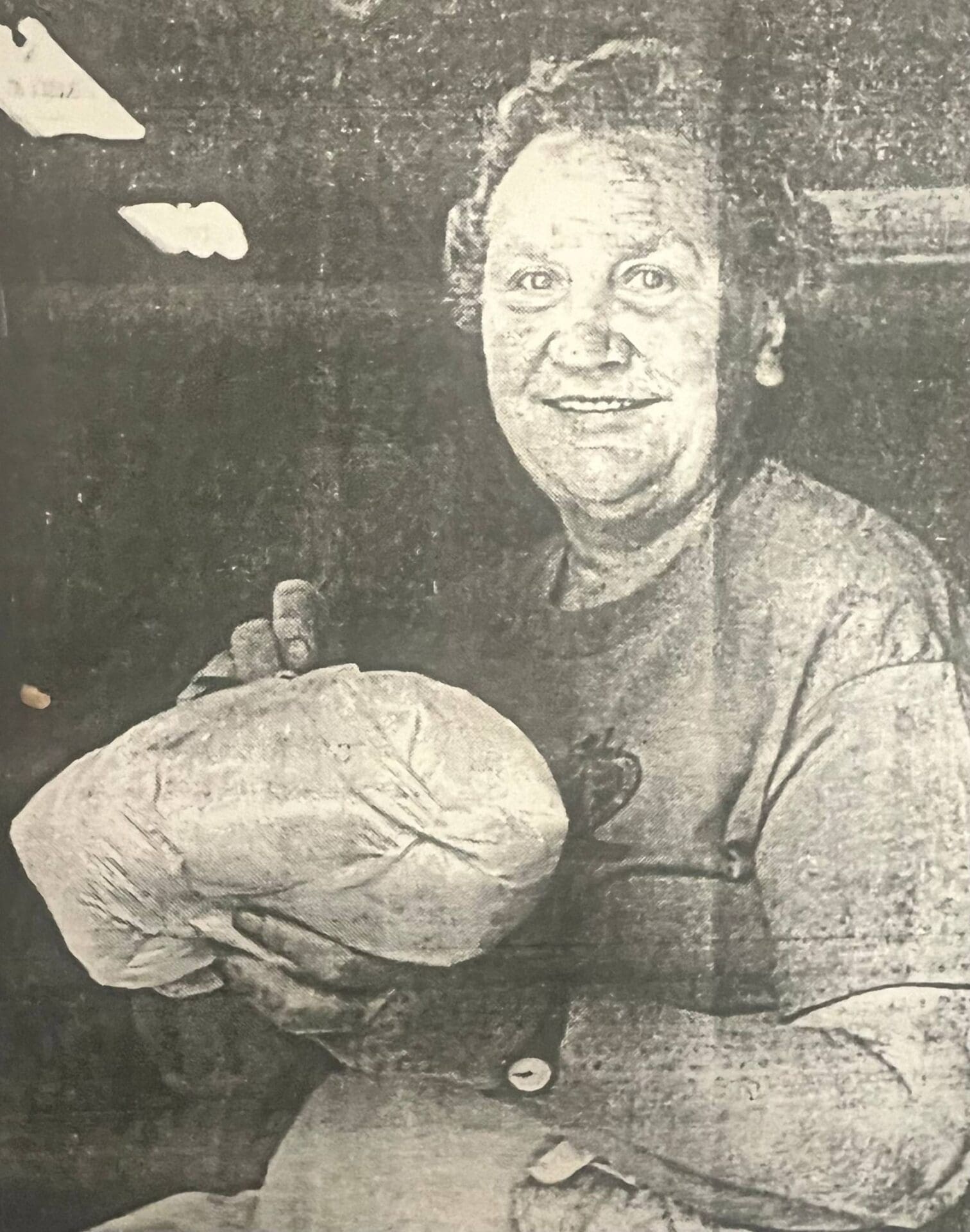
Dottie Czarnota
Humble Origins in 1969
In the fall of 1969, a simple idea sparked a delicious tradition in Southington, Connecticut. Paul Steinke of Zion Lutheran Church received an unusual donation – a 50-pound bag of flour – and, with his wife, proposed using it to make apple fritters for a new town festival. They approached a church member named Dorothea “Dot” Czarnota, known for her baking talents, to develop the recipe. Dot experimented with different methods – dipping apple rings, chunks, even wedges in batter – but none met approval. Finally, after much trial and error, Dot perfected a new apple fritter recipe that passed the taste test with flying colors. When the congregation sampled Dot’s fritters at the summer picnic, they were an instant hit. Buoyed by this success, the members of Zion Lutheran Church agreed to sponsor an apple fritter booth at the upcoming festival, not realizing they were about to launch a legend.
Early Years: From Church Kitchen to Festival Fame
That autumn, Southington held its first Apple Harvest Festival, and Zion Lutheran’s apple fritters made their debut. In those early years, the operation was truly homespun. Dot Czarnota herself oversaw much of the prep work – volunteers gathered at her home to peel bushels of apples and mix vast quantities of batter by hand. At the festival booth, the fritters were fried on the spot, originally scooped into the hot oil with teaspoons (later upgraded to ice-cream scoops) for consistency. Each warm, cinnamon-dusted fritter sold for just ten cents back then. The affordable price and indulgent aroma drew curiosity, but it was the first bite that hooked festivalgoers. Before long, Dot’s apple fritters became the surprise hit of the festival’s debut year. What began as a modest church fundraiser quickly grew into a centerpiece of the Apple Harvest Festival – one that would endure for generations.
Community demand for the fritters skyrocketed. Encouraged by the enthusiastic response, Zion Lutheran Church continued the fritter booth as an annual project. Dot’s husband, Larry Czarnota, joined her in refining and producing the treats; together they would be fondly credited as co-creators of the now-famous Zion apple fritters served each year. For the Czarnotas and their fellow parishioners, making fritters became a labor of love. Despite the long hours of peeling, mixing, and frying, Dot kept at it year after year – she was still helping oversee fritter production 45 years later, well into her late 80s, ensuring the recipe and quality remained unchanged. What had started with one bag of flour had blossomed into a beloved tradition.

Pastor Steinke
Becoming a Festival Icon
As the Apple Harvest Festival expanded over the decades, so too did the fame of Zion’s apple fritters. The festival itself grew into a major regional event – by the 2010s it was drawing around 100,000 visitors each year over its two weekends. And for many of those attendees, the first stop was the fritter tent. The demand became legendary, with queues that locals speak of with a mix of pride and disbelief. On busy days, the line for fritters can stretch about two blocks long, essentially wrapping around Southington’s town green. Festival organizers long ago closed off the central streets to traffic during event hours, as throngs of people stroll downtown chasing the scent of fried dough and spiced apples. Lawn chairs often appear at dawn as devotees stake out their place in the fritter line well before the booth opens, especially on parade days or weekends.
What keeps everyone waiting so patiently? One bite of a warm apple fritter explains it all. Each fritter is a golden-brown nugget of dough studded with fresh apple pieces, lightly dusted in sugar – crispy on the outside and soft inside, with a perfect balance of sweetness and spice. It’s a treat that screams New England autumn, encapsulating the harvest season in a few delicious mouthfuls. Remarkably, the recipe has never changed since Dot Czarnota invented it in 1969. The church guardians of this “secret recipe” have maintained its consistency and quality, which keeps longtime fans coming back year after year. “It’s been a tradition to make apple fritters for the last 50 years,” says Pat Garafola, a current co-chair of the fritter booth, “and we do the best we can to manage the lines.” Managing those lines is no small task – especially on peak days when the wait can test anyone’s patience. The volunteers have honed their operation to a science: from mixing the batter to frying and bagging a batch of fritters takes only about six minutes, and every effort is made to keep the queue moving efficiently. “We try to keep the wait down to 10 or 15 minutes,” Garafola notes, but on packed weekends “it’s pretty tough because [the line is] wrapped all the way around” the downtown area. Even so, visitors insist the fritters are “worth the wait,” and it’s not uncommon to see people merrily snacking from their paper bags of fritters while still in line to buy more.
Over time, a few mechanical innovations were introduced to help the church cope with the enormous demand. Large commercial mixers replaced hand-stirring to churn out dough in bulk. Custom fryers and dropping mechanisms were devised to fry more fritters at once with consistent results. In recent years, the operation reportedly uses astonishing quantities of ingredients – over four tons of apples (about 8,500 pounds) are peeled and diced for fritter production over the course of the festival. Massive propane-fired fryers run from dawn till dusk, tended by teams of apron-clad volunteers expertly flipping and scooping out fritters by the dozen. The moment a basket of fritters finishes frying, it’s drained, dumped onto a tray, and swiftly bagged into half-dozens and dozens to serve the next eager customers. That rhythm repeats itself thousands of times over festival week. Tens of thousands of fritters are sold each year – a staggering output for a church fundraiser that began on a shoestring. Yet despite scaling up, the core elements remain unchanged: the original recipe, the volunteer spirit, and the community’s appetite for this seasonal indulgence.
So integral have the apple fritters become to the festival that an official placard titled “The Story of the Apple Fritter” is proudly displayed at the booth, recounting Dot Czarnota’s founding role and giving credit to Paul Steinke’s wife for suggesting the idea back in 1969. Newcomers can read the lore while waiting in line, appreciating that they’re not just biting into a fritter – they’re tasting a bit of Southington history.
A Legacy of Community and Charity
One of the most remarkable aspects of the Zion apple fritter tradition is its deeper purpose. From the very beginning, the fritter booth’s primary goal was fundraising for worthy causes. All proceeds from fritter sales go to Zion Lutheran Church’s outreach and ministries, which in turn benefit the wider community. Over the decades, the fritter funds have helped support local charities and service organizations. For example, shelters and social services like the Prudence Crandall Center (a domestic violence shelter) and Southington Community Services have been beneficiaries, as have food security programs like Bread for Life (a local soup kitchen). The church has also directed fritter earnings to children’s charities such as The Cove Center for Grieving Children, and to veterans’ groups in town. In essence, anyone who enjoys a bag of fritters is not only treating themselves – they’re also indirectly supporting neighbors in need. As a sign at the booth reminds customers, “Your purchase of apple fritters enables Zion Lutheran Church to continue supporting ministries across town, throughout our nation, and around the world.”
This spirit of giving has fostered a special camaraderie at the fritter booth. Generations of church members have volunteered their time – taking shifts in the heat of the fryers, sugar-coating fritters, or handling cash – to keep the tradition alive. Families often volunteer together, passing down the “secret recipe” and work ethic to their children. Longtime volunteers recount stories of friendships forged over flour and oil, and the shared pride in seeing throngs of happy customers come back each year. The wider community pitches in too. In fact, the fritter booth has formed a partnership with the local Alex’s Lemonade Stand chapter: middle-school students set up a lemonade stand near the end of the fritter line, singing and cheering to encourage donations for childhood cancer research. Year after year, the generosity of fritter fans has flowed into that collection bucket as well, raising tens of thousands of dollars for charity in addition to the church’s own fundraising. It’s a virtuous cycle – everyone benefits from the apple fritter phenomenon in one way or another.
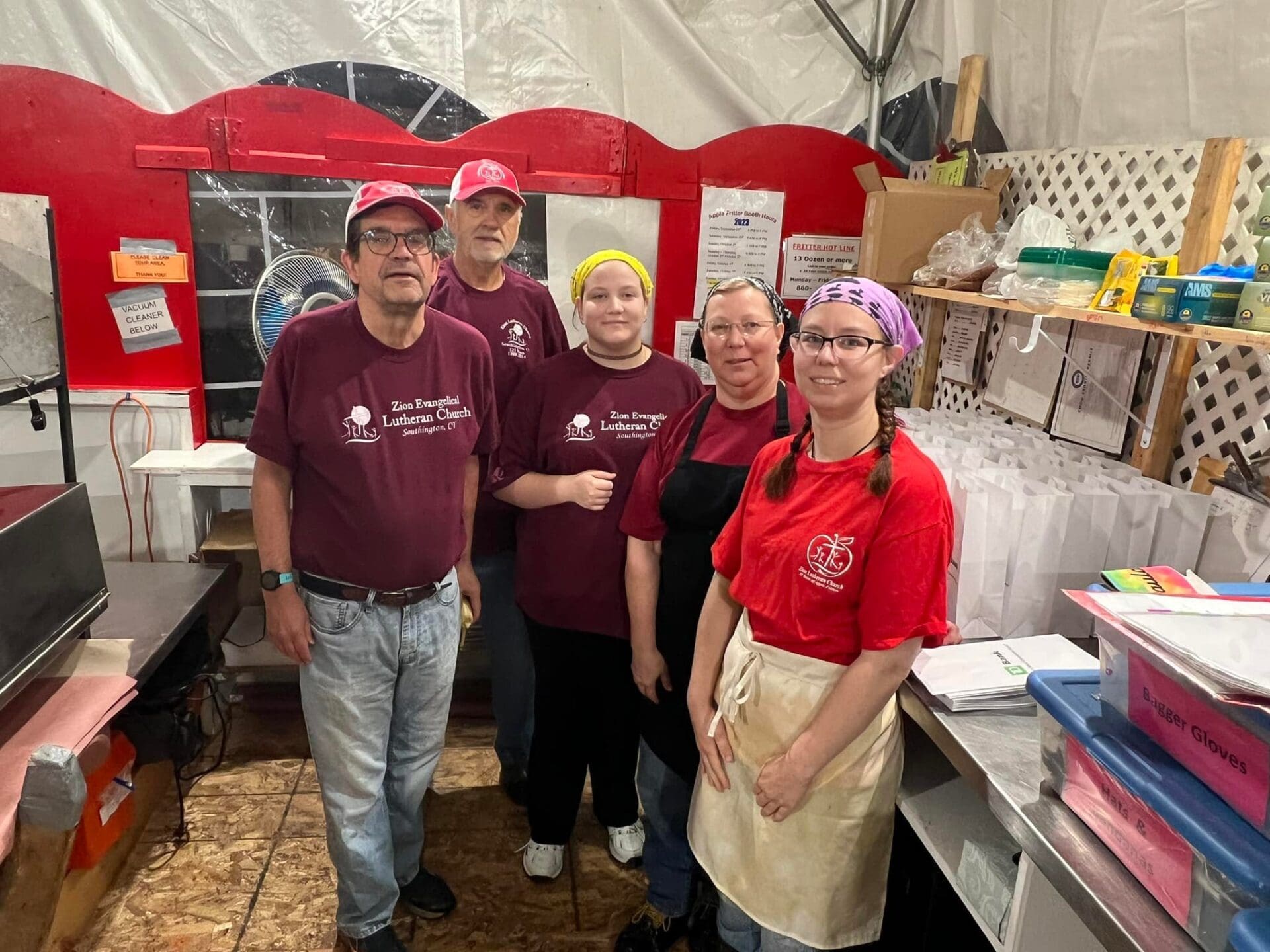
Continuing a Delicious Tradition
More than half a century since Dot Czarnota fried the very first batch, Southington’s apple fritters remain as popular as ever. The town’s Apple Harvest Festival – now held annually in early October – is consistently ranked among Connecticut’s must-visit fall events, and the fritters are its undisputed star attraction. Festival planners often highlight the treats in promotions, knowing that for many visitors, “you can’t have Apple Harvest without apple fritters.” Town officials have even joked that an apple fritter is something everyone can agree on: “I think we can all get around an apple fritter and it puts a smile on everybody’s face,” said one Southington councilman, emphasizing how the festival brings people together.
While Dot “Dottie” Czarnota, the fritter matriarch, passed away in 2014 at age 89, her legacy continues to shine every autumn in Southington. Many longtime residents still recall Dot cheerfully presiding over the fritter booth, and her picture even appears on the “Story of the Fritter” poster at the tent. Today, a dedicated committee – including folks like Pat and Lois Garafola, who have been involved for decades – carries the torch. They ensure Dot’s recipe remains unchanged and her standards upheld, so that each fritter bag handed across the counter lives up to the local lore. Younger volunteers have joined the ranks as well, some quite literally born into the tradition. Together, these volunteers feel a profound sense of stewardship for what has become a town treasure.
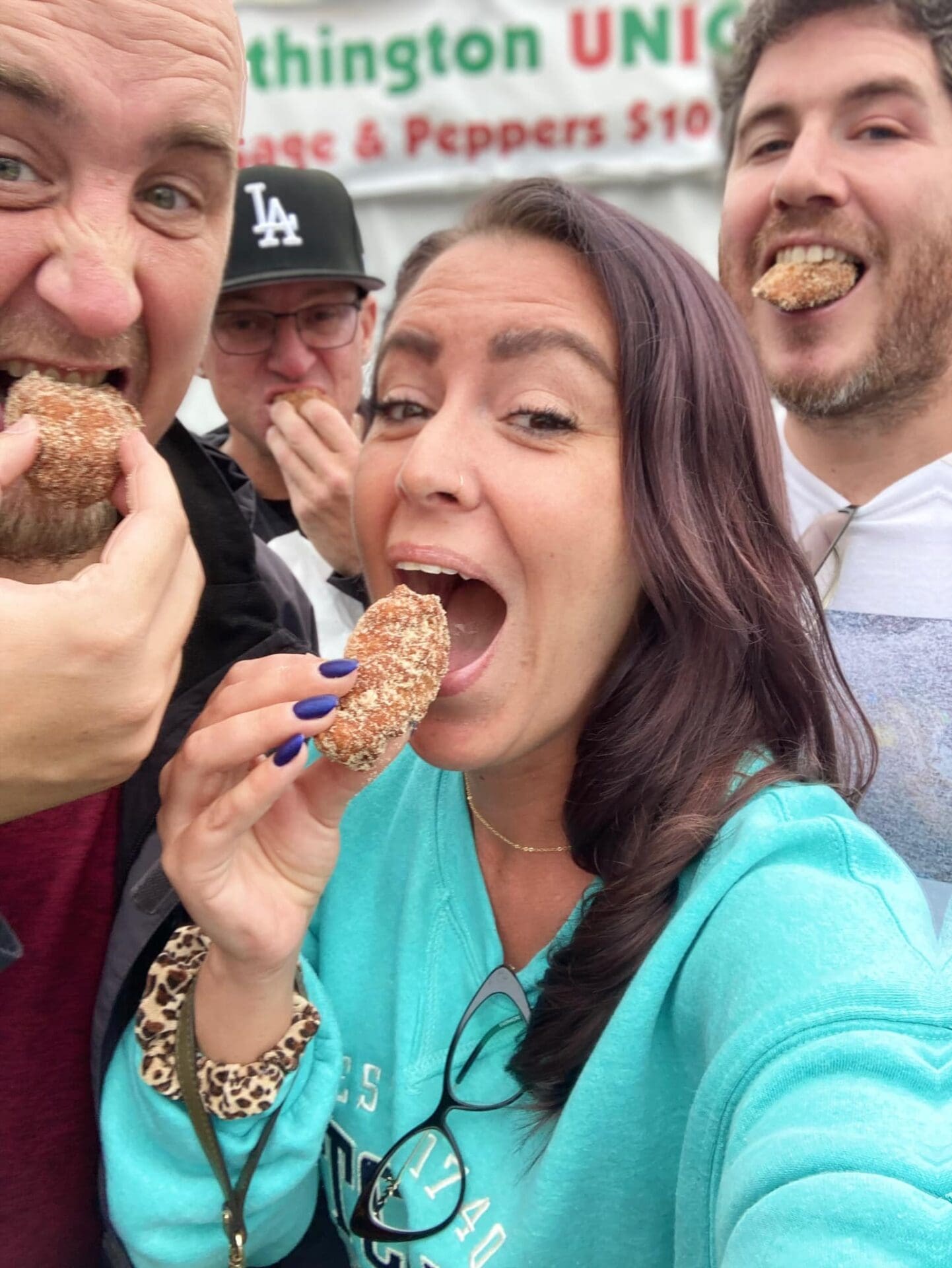
A Tradition That Still Brings Southington Together
Ultimately, the story of Southington’s apple fritters is about more than just fried dough – it’s about community, continuity, and pride. From that first 50-pound sack of flour and Dot Czarnota’s mixing bowl, a half-century of memories and goodwill has emerged, all dusted in powdered sugar. Each fall, the town gathers to celebrate its heritage and harvest, and the Zion apple fritter is the one treat that symbolizes it all: an embodiment of homegrown creativity, neighborly collaboration, and the simple joy of sharing something delicious. As long as Southington’s Apple Harvest Festival continues, you can bet the fritter lines will form at dawn, the fryers will sizzle, and happy festivalgoers will stroll the town green with sticky fingers and smiling faces – bonded by a beloved autumn tradition that shows no sign of slowing down.
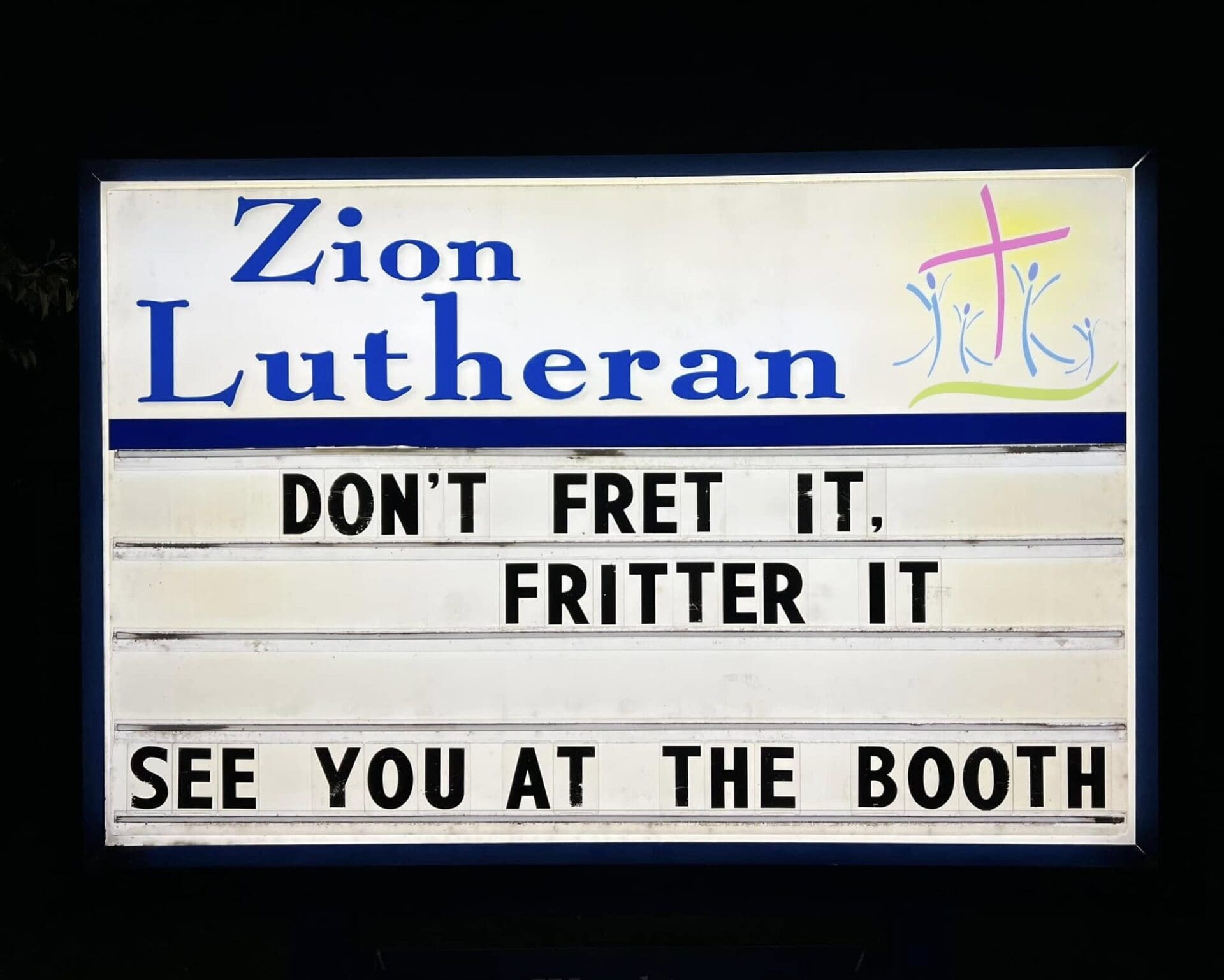
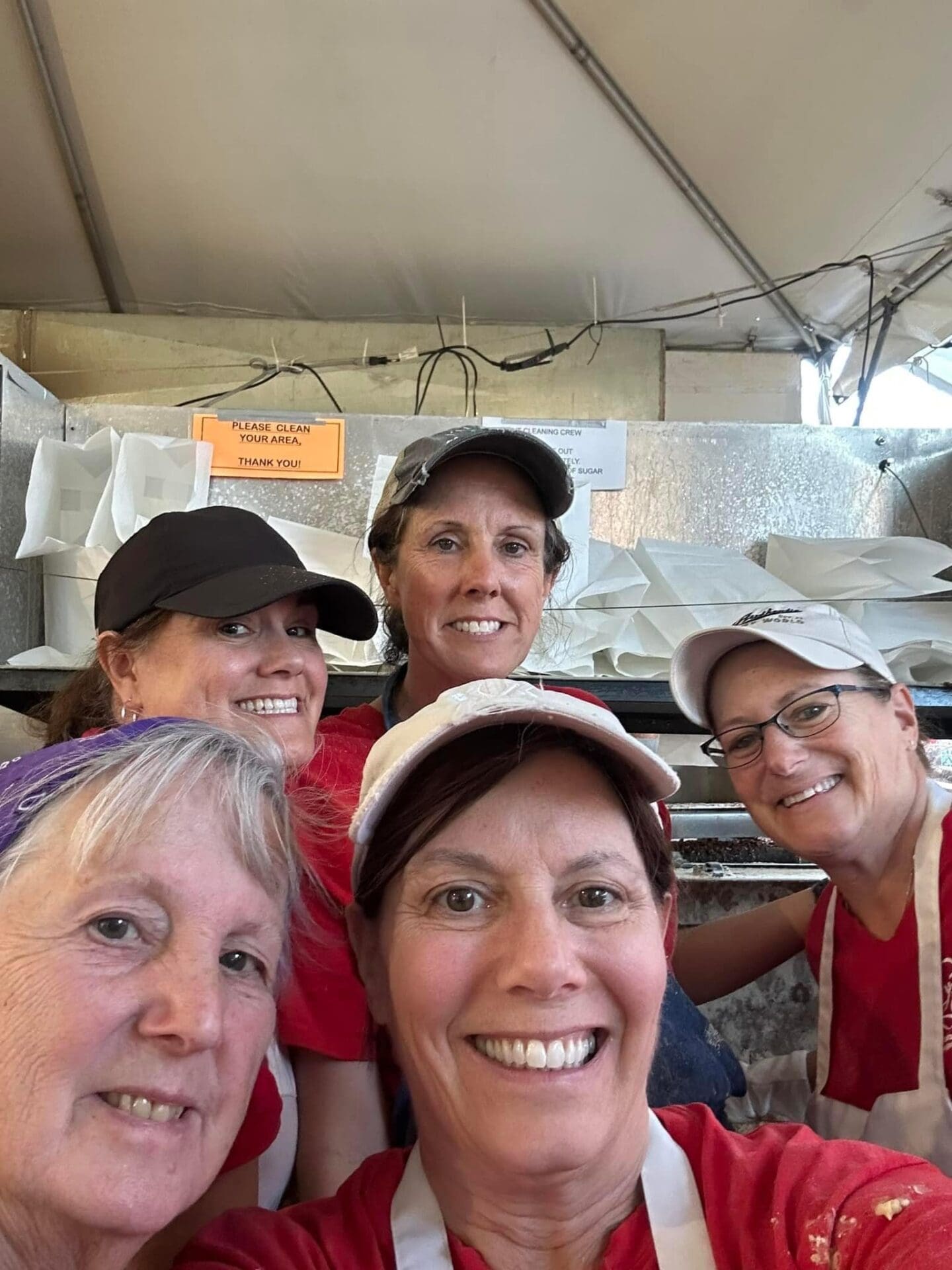
Thank You
A heartfelt thank you to every volunteer who has peeled apples, mixed batter, fried fritters, bagged orders, and greeted customers over the years. This tradition thrives because of your dedication. Each smile, each shift, and each shared story has helped turn a simple recipe into a treasured Southington legacy.
Sources
- Zion Lutheran Church – Apple Harvest Festival & Fritter History
- Zion Apple Fritters – Official History Page
- Central Recorder – Southington Apple Harvest Festival Coverage
- CT Insider – Apple Harvest Festival Coverage
- Legacy.com – Dorothea “Dot” Czarnota Obituary
- Legacy.com – Lawrence “Larry” Czarnota Obituary
- News & Views – Southington Apple Harvest Festival
